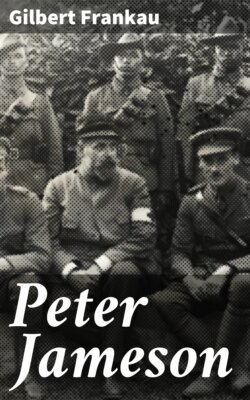Читать книгу Peter Jameson - Gilbert Frankau - Страница 6
На сайте Литреса книга снята с продажи.
§ 3
ОглавлениеTable of Contents
Peter the Third, our Mr. Jameson, was not born until his parents had been married nearly four years: John Gordon’s son, Francis, antedating him by about a week. In both of them, you can trace the Miraflores strain fairly clearly. They are both of them of medium height; stocky rather than tall. Both have the same curious eyes which seem to change colour—from gray to darkest black—with their thoughts. Both are small-handed, small-footed, rather determined about the nose, dark-haired, intelligent-headed. But life—and war, which is the same thing—has dealt with them so differently that, nowadays, you would have great difficulty in finding more than a fugitive likeness. You would say, and perhaps rightly, that Peter is less, Francis more, the Miraflores.
Dolores Gordon, despite her husband’s twelve thousand a year, presented him with no more children; but Tessa Jameson had another son—Peter’s brother Arthur—born in 1888.
Meanwhile, both businesses flourished: Gordon’s Limited, the larger; Jameson & Co., the sounder—providing John Gordon with a rather elaborate mansion in Curzon Street, West (to which he would return, late, tired and neurotic from the new offices in London Wall), and the Jamesons with a solid, rather tyrannous edifice in Lowndes Square, Kensington, wherein Peter’s father found comfortable refuge from the reflector-lit warehouse in Lime Street. By the late nineties, Peter the First’s few thousand pounds had grown—thanks largely to the sole agency for Beckmann cigars (of which more later)—into a fairly comfortable fortune, so that when John Gordon suggested to Peter the Second that both Peter the Third and Francis Gordon had better be sent to Eton College, money did not stand in the way.
The two cousins (Peter’s brother Arthur went to a less exalted establishment) did not distinguish themselves greatly at school. Francis was rather too flamboyant, Peter too self-concentrated, for easy friendships. However, Peter managed to get both his “Boats,” his “House Colours,” and Corporal’s stripes on his Volunteer tunic before he left: while Francis undoubtedly acquired there—in some mysterious way of his own—the beginnings of that literary technique in which he is now beginning to be acknowledged past-master.
From Eton, Peter went straight into the business. He had always found idleness intolerable, and Jameson’s seemed—regarded as “something to do”—made to his hand. To Francis and other Etonian acquaintances, the choice appeared an amazing one: but the boy’s father—lonely since his wife’s death about a year before, and conscious that his other son Arthur, whatever else he might become, would never be a business man—both understood and stimulated this desire for work.
